
第152章 CHAPTER XXI.(6)
Throughout a long experience in wild sports, although I admire the velocity of conical projectiles, I always have retained my opinion that, in jungle countries, where in the absence of dogs you require either to disable your game on the spot, or to produce a distinct blood-track that is easily followed, the old-fashioned two-groove belted ball will bag more game than modern bullets; but, on the other hand, the facility of loading a conical bullet already formed into a cartridge is a great advantage. The shock produced by a pointed projectile is nothing compared to that of the old belted ball, unless it is on the principle of Purday's high velocity expanding bullet, which, although perfection for deer-shooting, would be useless against thick-skinned animals, such as buffalo and rhinoceros. In Africa, the variety of game is such, that it is impossible to tell, when loading, at what animal the bullet will be fired; therefore, it is necessary to be armed with a rifle suitable for all comers. My little Fletcher was the Enfield bore, No. 24, and, although a most trusty weapon, the bullets generally failed to penetrate the skull of hippopotami, except in places where the bone was thin, such as behind the ear, and beneath the eyes. Although I killed great numbers of animals with the Enfield bullet, the success was due to tolerably correct shooting, as I generally lost the larger antelopes if wounded by that projectile in any place but the neck, head, or shoulder; the wound did not bleed freely, therefore it was next to impossible to follow up the blood-track;thus a large proportion of wounded animals escaped.
I saw, and shot, thirteen varieties of antelopes while in Africa.
Upon arrival at Khartoum, I met Herr von Heuglin, who commanded the expedition in search of Dr. Vogel; he was an industrious naturalist, who had been many years in the Soudan and in Abyssinia. We compared notes of all we had seen and done, and he very kindly supplied me with a list of all the antelopes that he had been able to trace as existing in Abyssinia and the Soudan;he now included my maarif, which he had never met with, and which he agreed was a new species. In the following list, which is an exact copy of that which he had arranged, those marked with an asterisk are species that I have myself shot:--Catalogue des especes du genre "ANTILOPE," observees en Egypte, dans la Nubie, au Soudan orientale et en Abissinie.
A.--GAZELLA, Blains.
1.--Spec. G. Dorcas.* Arab. Ghasal.
2.--G. Arabica,* Ehr. A la cote de la Mer rouge.
3.--G. Loevipes, Sund. Arab. Abou Horabet? Nubie, Taka, Sennaar, Kordofan.
4.--G. spec. (?) en Tigreh Choquen (Bogos).
5.--G. Dama,* Licht. Arab. Adra, Ledra. Riel, Bajouda, Berber, Sennaar, Kordofan.
6.--G. Soemmeringii, Rupp. Arab. Om Oreba. Tigreh, Arab. Taka, Massowa, Gedaref, Berber, Sennaar.
7.--G. Leptoceros. Arab. Abou Harab. Gazelle a longues cornes, minces et paralleles. Bajouda, Berber, Taka, Sennaar, Kordofan.
B.--CALOTRAGUS, Luad.
8.--C. montanus,* Rupp. Arab. Otrab and El Mor. Amhar, Fiego, Sennaar, Abissinie, Taka, Galabat.
9.--C. Saltatrix, Forst. Amhar. Sasa. Abissinie.
C.--NANOTRAGUS, Wagn.
10.--N. Hemprichianus, Ehr. Arab. Om dig dig. Abissinie orientale et occidentale, Taka, Kordofan.
D.--CEPHALOLOPHUS, H. Smith.
11.--C. Madaqua. Amhar. Midakoua. Galabat, Barka, Abissinie.
12, 13.--Deux especes inconnues du Fleuve blanc, nominees par les Djenkes, "Amok."E.--REDUNCA.
14.--R. Eleotragus, Schrb. Djenke, Bor. Bahr el Abiad.
15.--R. Behor, Rupp. Amhar. Behor. Abissinie centrale, Kordofan.
16.--R. Kull, nov. spec. Djenke, Koul. Bahr el Abiad.
17.--R. leucotis, Peters et Licht. Djenke, Adjel. Bahr el Abiad, Saubat.
18.--R. Wuil, nov. spec. Djenke, Ouil. Bahr el Abiad, Saubat.
19.--R. Lechee,* Gray. Bahr el Abiad.
20.--R. megcerosa,* Heuglin. Kobus Maria, Gray. Djenke, Abok, Saubat, Bahr el Abiad et Bahr Ghazal.
21.--R. Defassa,* Rupp. Arab. Om Hetehet. Amhar. Dofasa. Djenke, Bor. Bahr el Salame, Galabat, Kordofan, Bahr el Abiad, Dender, Abissinie occidentale et centrale.
22.--R. ellipsiprymna, Ogilby. Djenke, Bor. Bahr el Abiad.
F.--HIPPOTRAGUS, Sund.
23.--H. niger, Harris. Arab. Abou Maarif. Kordofan meridionale, fleuve Blanc (Chilouk).
24.--H. nov. spec. Arab. Abou Maarif.*--Bakerii.* Bahr el Salaam, Galabat Dender, fleuve BIeu, Sennaar meridionale.
25.--H. Beisa, Rupp. Arab. Beisa et Damma. Souakim, Massowa, Danakil, Somauli, Kordofan.
26.--H. ensicornis, Ehr. Arab. Ouahoh el bagr. Nubie, Berber, Kordofan.
27.--H. Addax, Licht. Arab. Akach. Bajouda, Egypte occidentale (Oasis de Siouah).
G.--TAUROTRAGUS, Wagn.
28.--T. Orcas, Pall. (Antilope Canna). Djenke, Goualgonal. Bahr el Abiad.
29.--T. gigas, nov. spec. Chez les pleuplades Atoats, au Bahr el Abiad.
H.--TRAGELAPHUS, Blains.
30.--Tr. strepsiceros (Pallas). Arab. Nellet, Miremreh. Tigreh, Garona. Ambar. Agazen. Abissinie, Sennaar, Homran, Galabat, Kordofan.
31.--Tr. sylvaticus, Spaerm. Bahr el Abiad.
32.--Tr. Dekula, Rupp. Amhar. Dekoula. Arab. Houch. Djenke, Ber.
Taka, Abissinie, Bahr el Abiad.
I.--BUBALIS.
33.--B. Mauritanica, Sund. (Antilope Bubalis, Cuvier). Arab.
Tetel; Tigreh, Tori. Taka, Homran, Barka, Galabat, Kordofan, Bahr el Abiad.
34.--B. Caama, Cuv. Arab. Tetel. Djenke, Awalwon. Bahr el Abiad, Kordofan meridionale.
35.--B. Senegalensis, H. Smith. Bahr el Abiad.
36.--B. Tiang, nov. spec. Djenke, Tian. Bahr el Abiad, Bahr Ghazal.
37.--B. Tian-riel, nov. spec. Bahr el Abiad.
SPECIES INCERTAE
"Soada," au Oualkait et Mareb (Taurotragus?).
"Uorobo," au Godjam, Agow (Hippotragus).
"Ouoadembi." March, Oualkait (Hippotragus).
"El Mor." Sennaar, Fazogle (Nanotragus?).
"El Khondieh." Kordofan (Redunca?).
"Om Khat." Kordofan (Gazella?).
"El Hamra." Kordofan, Bajouda (Gazella?).